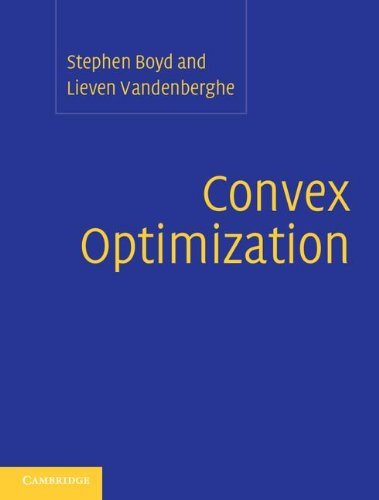
学习Convex Optimization资料分享
1
0

红旗党员 2023-05-18 12:54:47
23Spring上的一门印象深刻的课,上完之后人都聪明很多。本书最大的特点是有极多的应用案例,涉及领域众多,涵盖signal processing、system and control theory、estimation、statistics、operations research、finance、information theory、digital and analog circuit design和machine learning等领域,对于理解如何使用凸优化有很大帮助。
全书分为三个部分:
1.基本概念(凸集、凸函数、凸优化问题、对偶)
2.应用(最小二乘法、线性和二次规划、半定规划、极小极大问题)
3.算法(下降、等式/不等式约束最小化问题等)
另外,附录部分有一些矩阵变换和数值方法。其中最实用的trick是Schur complement和epigraph转换问题成SDP,也可以当工具书用。
全书地址:https://web.stanford.edu/~boyd/cvxbook/bv_cvxbook.pdf
书后习题答案:https://egrcc.github.io/docs/math/cvxbook-solutions.pdf
幻灯片:https://web.stanford.edu/class/ee364a/lectures.html
Additional exercises(含m文件、Julia、Python、Matlab工具包):https://github.com/cvxgrp/cvxbook_additional_exercises
Additional exercises solution manual:https://github.com/Haoming99/CVX/blob/main/Stephen_Boyd__Lieven_Vandenberghe_-_Additional_Exercises_for_Convex_Optimization_with_Solutions_2016.pdf
Stanford final exams:https://github.com/Haoming99/CVX
本课的先修课是线性代数,至少需要掌握矩阵分解,chapter9之后则需要一些矩阵微积分的知识。如果真想学懂这门课,需要完成书后习题。但是,Prof.Boyd的书后习题答案错误颇多且相当简略,需要仔细辨别。
相关推荐
萤火谷的梦想家
艾莉森•麦吉出生于1960年,是美国《纽约时报》畅销书作家,同时也是大都会州立大学创意写作课的教授。她的作品被翻译成20多种语言并出版,也曾被提名普利策奖,并获得苏斯博士奖金奖、克里斯托弗图书奖、美国 [美]艾莉森•麦吉/[美]克里斯托弗•丹尼斯/绘 2023-03-27 16:50:25鬼马女神捕1·绝密卧底(上)
腹黑凤凰vs毒舌鸡妖——蓝翎:“小姬,跟我去人界吧!”姬十四:“干吗?让人宰了我做小鸡炖蘑菇吗?”蓝翎:“不啊,让妖怪宰了你做小鸡炖蘑菇更气派。”凤凰蓝翎和鸡妖姬十四生活在无忧无虑的灵界。他们的故乡叫 郝天晓 2023-04-17 00:22:47© 2023-2025 百科书库. All Rights Reserved.












发表评价